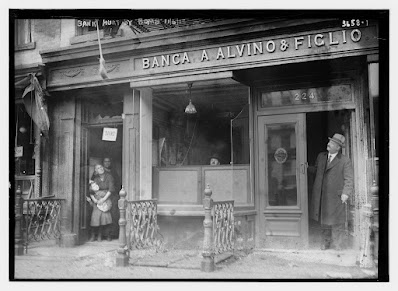By Michelle Shocklee
One of the things I enjoy most about being an author of historical fiction is learning about people who came before us. In my new split-time novel, Count the Nights by Stars, two of the main characters have Italian roots. In order to create authentic lives for them, I had to dig into an area of research that was new to me.
Today, I'd like to share some of it with you. I'll take you on a tour of an 1890s immigrant community called Little Italy in the heart of New York City, but first, the history.
By the late 19th century, Italy had suffered decades of internal strife that left a legacy of violence, social unrest, and widespread poverty. The peasant class in southern, mostly rural Italy, as well as those living on the island of Sicily, had little hope of improving their lot. Disease and natural disasters added to the misery, leaving people desperate, homeless, and searching for something better.
As transatlantic transportation became more affordable, and as word of American prosperity spread throughout Europe--often brought to Italy by men called "recruiters" hoping to convince people to immigrate to the United States--many Italians found it increasingly difficult to resist the call of "L'America."
 |
| Immigrants on their way to Ellis Island, on the deck of the S.S. Patricia, 1906. (Credit: Library of Congress/Popperfoto/Getty Images) |
Once these brave immigrants reached American soil, however, life often wasn't what they'd dreamed. An influx of immigrants from other countries--Germany, Ireland, and China--meant jobs for foreigners were limited. Housing, too, was inadequate to accommodate the huge numbers of people arriving at Ellis Island. Crowded, disease-ridden tenements were all that was affordable or available to them.
 |
| A bank in Little Italy. Circa 1897. |
Little Italy was not the largest Italian neighborhood in New York City, as East Harlem (or Italian Harlem) had a larger Italian population. However, it was the city's poorest Italian neighborhood. But despite the hardships, disease, and crime, the immigrants who lived there fought to make a life in America for themselves as well as for their children and their children's children. Their legacy can still be seen in the Little Italy of today, where Italian food, music, and the language is enjoyed by visitors and residents alike.
 |
| Little Italy tenement. Circa 1897. I can almost picture Luca and Gia, characters in my book, living here. 😢 |
 |
| A street musician and a cop on Mulberry Street, 1897 (Museum of City of New York). |
 |
| Mulberry Street, 1897. (Museum of City of New York) Readers, do you think one of these boys might be Luca when he was growing up in Little Italy? |
Michelle Shocklee is the author of several historical novels, including Under the Tulip Tree, a Christy Awards and Selah Awards finalist. Her work has been included in numerous Chicken Soup for the Soul books, magazines, and blogs. Married to her college sweetheart and the mother of two grown sons, she makes her home in Tennessee, not far from the historical sites she writes about. Visit her online at www.MichelleShocklee.com
https://www.tyndale.com/p/count-the-nights-by-stars/9781496459930

.jpg)


Thanks for posting today. I have never been to Little Italy. I enjoy novels about the immigrants' journeys into their new lives though.
ReplyDeleteThank you, Connie! I enjoy those types of novels too!
DeleteI grew up in NJ, so we visited NYC often, but I can't remember going to Little Italy.
ReplyDelete